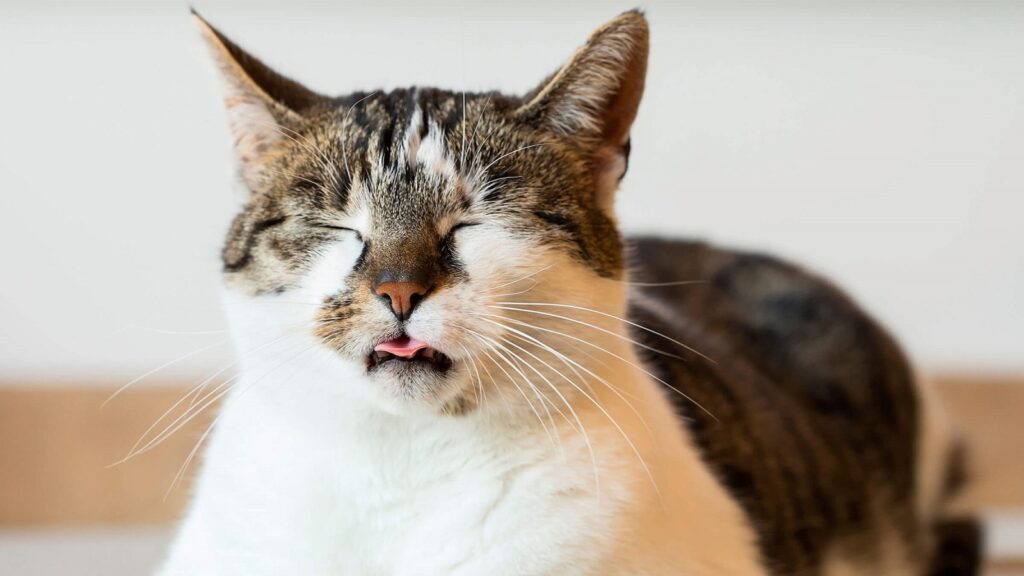Feline Rhinotracheitis is a respiratory disease suffered by cats, which is of viral origin and is located mainly in the upper airways. It spreads very easily as it can be transmitted with a simple sneeze. Although there is no cure, if the kitten is treated appropriately, it usually has a benign prognosis.

Feline Rhinotracheitis
Viral upper airway disease of cats is better known by the name feline rhinotracheitis, which is usually caused by feline herpesvirus and/or feline calicivirus. The condition can be transmitted through direct contact between kittens, and despite the fact that it has a benign prognosis, some fatal cases or those that have left permanent consequences have been known.
What is Feline Rhinotracheitis?
When caused by the herpesvirus, its duplication occurs in the nasal, tracheal and conjunctival membranes. In the case of calicivirus, added to the previous locations, it can also be duplicated in the lung or in the oral mucosa, which justifies the differences in the symptoms that are manifested.
This respiratory ailment is also referred to as cat flu and can occur at any age. However, it more commonly affects younger or older individuals, who may experience severe complications. Both herpesviruses and caliciviruses can spread rapidly in cat colonies, from which they are very difficult to eliminate. For this reason, feline rhinotracheitis is very feared in shelters, cattery and shelters for cats.
Latency
In addition to the acute symptomatology, feline rhinotracheitis is a condition that can be chronic, and in the case of Herpesvirus the animal remains in a state of chronic latency, which causes that in conditions of stress, disease, surgery or dosage of glucocorticoids, viruses replicate again and thus shed abroad, often with mild clinical symptoms.
Particularly in the case of calicivirus, it is continuously shed via the oropharyngeal route without the presence of clinical symptoms in many cases, generating the infection of other cats.
How is it spread?
The viruses of this condition are transmitted very easily through small droplets that the feline spreads when sneezing. Likewise, contagion can occur through tears and nasal mucus. Added to this, a person's clothing or anything that the affected cat has rubbed its face on are a potential source of contagion. In this way, the cat remains a carrier for life and, in addition to contagion from its peers, it can suffer reactivations of the disease, although not at a serious level.
symptomatology
Feline rhinotracheitis can manifest at any age but generally tends to afflict younger kittens more frequently. Herpesvirus causes symptoms that last 2 to 4 weeks while calicivirus symptoms last 1 to 2 weeks. Among the most common manifestations of feline rhinotracheitis are:
- Sneezing
- Tearing
- Fever
- runny nose
- Conjunctivitis
- Blepharospasm
- Hypersalivation
- Cough
- Loss of appetite
- Apathy
Herpesvirus infection can cause ulcerative keratitis, while calicivirus can cause pneumonia and ulcerative stomatitis, particularly on the tongue and palate. Both viruses could be involved in the etiopathogenesis of severe lymphoplasmacytic stomatitis-gingivitis, which is very frequent in felines.
Likewise, symptoms of anorexia, depression, fever, dehydration can be externalized according to the condition of the animal and the appearance of respiratory infections due to opportunistic germs. On certain occasions, inspiratory dyspnea may occur due to the manifestation of profuse excretions in the respiratory tract.
Forecast
Although it is subject to the basal state of the feline, its prognosis is usually benign, despite the fact that very serious complications can occur in puppies lacking nutrition or strength.
Treatment of Feline Rhinotracheitis
The veterinarian will request laboratory tests to corroborate the diagnosis, but there is no curative treatment for this condition, despite the fact that symptoms can be calmed or certain complementary bacterial infections can be prevented and treated. For example, amoxicillin is used, which is a broad-range antibiotic. Added to it:
- If the animal shows purulent conjunctivitis, the supply of antibiotic eye drops will be prescribed.
- In smaller or weaker individuals a quality diet is essential for support.
- If the feline becomes dehydrated, fluid therapy is necessary.
- The use of corticosteroids is recommended if lymphoplasmacytic stomatitis-gingivitis occurs (in chronic calicivirus vectors).
- Commonly used disinfectants are efficient at suppressing viruses, but it is essential to maintain an appropriate general cleanliness of the spaces.
- The separation of infected specimens or those presumed to have contracted the virus is required.
The good news is that most felines manage to recover if treated properly, yet a large proportion of them will show lasting sequelae. Such as, for example, the obstruction of the nostrils, abundant nasal excretion and severe infections of the eyes.
It is still valid that prevention is better than cure, in such a way that the ideal is for the cat to be vaccinated following the instructions of the veterinarian. Although it is known that vaccines can lessen the severity of the disease, it is not usual for them to prevent infection or for cats to become carriers.
The vaccine for puppies can be applied from week 8 or 9, repeating the dose at 4 weeks and then annually. Since there are several strains of calicivirus, it must be borne in mind that, despite the fact that the cat has received its vaccine, it may show mild symptoms after being exposed to the virus.
Other recommended articles are:


